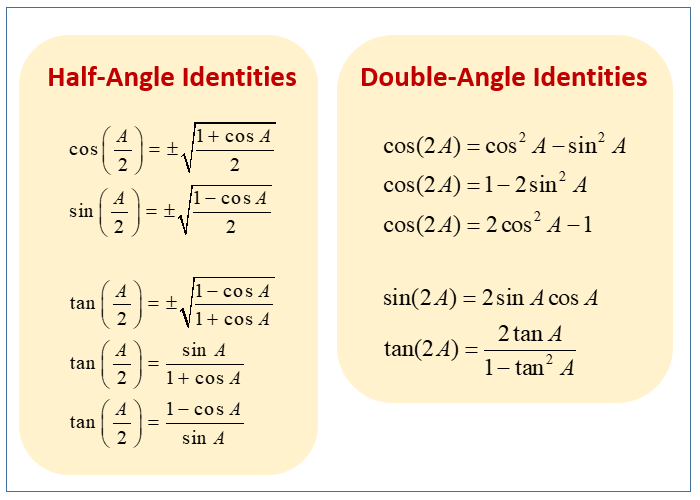Half Angle Identities
Related Topics:
More Lessons for PreCalculus
Math Worksheets
Examples, solutions, videos, worksheets, and activities to help PreCalculus students learn how to derive and use the half angle identities.
Half-Angle Identities
Half-angle identities are a set of trigonometric formulas that express the trigonometric functions (sine, cosine, and tangent) of half an angle \(\frac{θ}{2}\) or \(\frac{A}{2}\) in terms of the trigonometric functions of the original angle (θ or A). They are useful for simplifying expressions, solving trigonometric equations, and finding exact values for angles that aren’t standard (like 15° or 22.5°).
The following diagrams show the half-angle identities and double-angle identities. Scroll down the page for more examples and solutions on how to use the half-angle identities and double-angle identities.

Half-angle identities are directly derived from the cosine double-angle identities.
Important Note on the ± Sign:
For the sine and cosine half-angle identities, the choice of the plus or minus sign depends on the quadrant in which the half-angle \( \frac{A}{2}\) lies, not the original angle \(A\). You need to determine the quadrant of \( \frac{A}{2}\) to choose the correct sign.
Half Angle Identities to Evaluate Trigonometric Expressions
This video gives some half angle identities and show how they can be used to solve some trigonometric equations.
Example:
Find the exact value of the following:
sin(22.5°)
Half Angle Identities to Evaluate Trigonometric Expressions, Example 2.
Example:
Find the exact value of the following:
tan(105°)
Half Angle Identities to Evaluate Trigonometric Expressions, Example 3.
Example:
Find sin(9/2) if cos a = 3/5 for 9° ≤ a ≤ 90°
Solving Trigonometric Equations using Half-Angle Identities
Example:
Solve tan (x/2) + sin x = 0 for x ∊ [0, 2π}
How half-angle identities can be used to determine function values?
Example:
- Determine the exact value of sin(π/8)
- Determine the exact value of cos(105°)
- Given cos A = -2/3 in quadrant II, determine cos(A/2), sin(A/2) and tan(A/2).
Using half-angle formulas in trigonometry
Example:
Let sin A = 4/5 with A in quadrant II.
Find
- sin (A/2)
- cos 2A
- sec 2A
Derive and use Half-Angle Identities
The derivations of the half-angle identities for both sine and cosine, plus listing the tangent ones. Then a couple of examples using the identities.
Examples:
- Find the exact value for sin (9π/8)
- Find cos x/2 if sin x = -4/5 with 3π/2 < x < 2π
How to derive the half angle trigonometry identities for cosine, sine and tangent?
The Half-Angle Identities
The half angle identities come from the power reduction formulas using the key substitution α = θ/2 twice, once on the left and right sides of the equation. With half angle identities, on the left side, this yields (after a square root) cos(θ/2) or sin(θ/2); on the right side cos(2α) becomes cos(θ) because 2(1/2) = 1. For a problem like sin(pi/12), remember that θ/2 = π/12, or θ = π/6, when substituting into the identity.
How to use the power reduction formulas to derive the half-angle formulas?
Try out our new and fun Fraction Concoction Game.
Add and subtract fractions to make exciting fraction concoctions following a recipe. There are four levels of difficulty: Easy, medium, hard and insane. Practice the basics of fraction addition and subtraction or challenge yourself with the insane level.

We welcome your feedback, comments and questions about this site or page. Please submit your feedback or enquiries via our Feedback page.